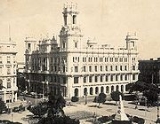
Museo Nacional de Bellas Artes de La Habana
Encyclopedia
The National Museum of Fine Arts of Havana (Museo Nacional de Bellas Artes de La Habana) in Havana
, Cuba
is a museum of Fine Arts that exhibits Cuban art collections from the colonial times up to contemporary generations. It was founded on February 23, 1913 due to the efforts of its first director, Emilio Heredia, a well-known architect
. After frequent moves it was finally placed on the block once occupied by the old Colon Market. In 1954, a new Palacio of Bellas Artes was opened, designed by the architect Rodriguez Pichardo. The original 1954 Palacio was recently reconstructed by the architect Jose Linares and a second building was taken over for the Museum.
There are now two impressive buildings belonging to the Museum, one dedicated to Cuban Arts in the Palacio de Bellas Artes (Palace of Fine Arts) and one dedicated to the Universal Arts, in the Palacio del Centro Asturiano (Palace of the Asturian Center).
The Palacio de Bellas Artes (Palace of Fine Arts) is dedicated exclusively to housing Cuba Art collections. Spanning the 17th and 19th centuries has rooms devoted to landscape, religious subjects and the Costumbrismo narrative scenes of Cuban life. Gallery devoted to the 1970s is marked by a preponderance of Hyperrealism and the latest generation of Cuban artists whose works all reflect the strong symbolic imagery that has been prevalent in recent decades. The most notable works are those of René Portocarrero
and Wifredo Lam
. A modernist sculpture by noted Cuban artist Rita Lonja stands outside the main entrance.
 In the Palacio del Centro Asturiano (Palace of the Asturian Center) built in 1927 by the architect Manuel Bustos European paintings and sculptures, along with a collection of ancient art are on displayed there. Originally, it was a club for natives of the Spanish Province of Asturias and after the 1959 Revolution it housed the Supreme Court of Justice.
In the Palacio del Centro Asturiano (Palace of the Asturian Center) built in 1927 by the architect Manuel Bustos European paintings and sculptures, along with a collection of ancient art are on displayed there. Originally, it was a club for natives of the Spanish Province of Asturias and after the 1959 Revolution it housed the Supreme Court of Justice.
Havana
Havana is the capital city, province, major port, and leading commercial centre of Cuba. The city proper has a population of 2.1 million inhabitants, and it spans a total of — making it the largest city in the Caribbean region, and the most populous...
, Cuba
Cuba
The Republic of Cuba is an island nation in the Caribbean. The nation of Cuba consists of the main island of Cuba, the Isla de la Juventud, and several archipelagos. Havana is the largest city in Cuba and the country's capital. Santiago de Cuba is the second largest city...
is a museum of Fine Arts that exhibits Cuban art collections from the colonial times up to contemporary generations. It was founded on February 23, 1913 due to the efforts of its first director, Emilio Heredia, a well-known architect
Architect
An architect is a person trained in the planning, design and oversight of the construction of buildings. To practice architecture means to offer or render services in connection with the design and construction of a building, or group of buildings and the space within the site surrounding the...
. After frequent moves it was finally placed on the block once occupied by the old Colon Market. In 1954, a new Palacio of Bellas Artes was opened, designed by the architect Rodriguez Pichardo. The original 1954 Palacio was recently reconstructed by the architect Jose Linares and a second building was taken over for the Museum.
There are now two impressive buildings belonging to the Museum, one dedicated to Cuban Arts in the Palacio de Bellas Artes (Palace of Fine Arts) and one dedicated to the Universal Arts, in the Palacio del Centro Asturiano (Palace of the Asturian Center).
The Palacio de Bellas Artes (Palace of Fine Arts) is dedicated exclusively to housing Cuba Art collections. Spanning the 17th and 19th centuries has rooms devoted to landscape, religious subjects and the Costumbrismo narrative scenes of Cuban life. Gallery devoted to the 1970s is marked by a preponderance of Hyperrealism and the latest generation of Cuban artists whose works all reflect the strong symbolic imagery that has been prevalent in recent decades. The most notable works are those of René Portocarrero
René Portocarrero
René Portocarrero was a Cuban artist recognised internationally for his achievements.-History:...
and Wifredo Lam
Wifredo Lam
Wifredo Óscar de la Concepción Lam y Castilla , better known as Wifredo Lam, was a Cuban artist who sought to portray and revive the enduring Afro-Cuban spirit and culture...
. A modernist sculpture by noted Cuban artist Rita Lonja stands outside the main entrance.

Address
- Palace of Fine Arts - Trocadero Street e/Zulueta y Monserrate, Old HavanaOld HavanaOld Havana contains the core of the original city of Havana. The positions of the original Havana city walls are the modern boundaries of Old Havana....
, HavanaHavanaHavana is the capital city, province, major port, and leading commercial centre of Cuba. The city proper has a population of 2.1 million inhabitants, and it spans a total of — making it the largest city in the Caribbean region, and the most populous...
, CubaCubaThe Republic of Cuba is an island nation in the Caribbean. The nation of Cuba consists of the main island of Cuba, the Isla de la Juventud, and several archipelagos. Havana is the largest city in Cuba and the country's capital. Santiago de Cuba is the second largest city...
10200 - Palace of the Asturian Center - San Rafael, e/Zulueta y Monserrate, Old Havana, Havana, Cuba 10200

